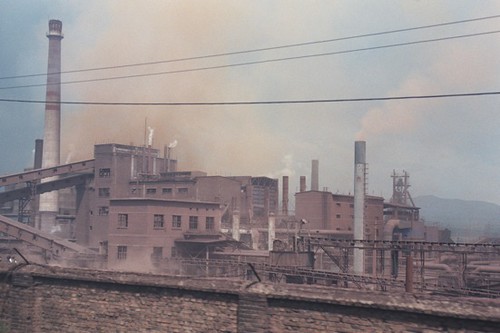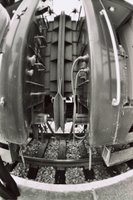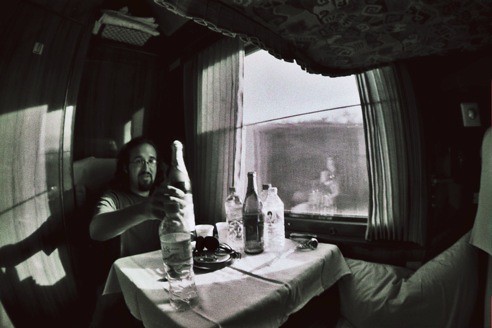Early morning.
 We are exiting Beijing en-route to Ulaan Baatar on the #3 Trans-Mongolian Express. It departed from the Beijing Railway Station right on time at 7:40 AM. Our leg of the trip will take approximately 33 hours, after which the train continues on to Moscow on a five-day journey through Siberia. Our comfy cabin sleeps two and has a large window and a washbasin connected to the neighboring berth. I sit by the window with my camera admiring the passing scenes of a metropolis that is home to over 15 million people. The sights are diverse as we pass construction projects and high-rise condominiums squeezed between the familiar narrow-alleyed hutongs. Soon, as in some parts of the city, all the hutongs will likely capitulate to modern architecture. In the distance I can count up to 14 cranes in one area of the city. Numerous more pass by the window before we reach the outlying farmland of the Beijing suburbs an hour later.
We are exiting Beijing en-route to Ulaan Baatar on the #3 Trans-Mongolian Express. It departed from the Beijing Railway Station right on time at 7:40 AM. Our leg of the trip will take approximately 33 hours, after which the train continues on to Moscow on a five-day journey through Siberia. Our comfy cabin sleeps two and has a large window and a washbasin connected to the neighboring berth. I sit by the window with my camera admiring the passing scenes of a metropolis that is home to over 15 million people. The sights are diverse as we pass construction projects and high-rise condominiums squeezed between the familiar narrow-alleyed hutongs. Soon, as in some parts of the city, all the hutongs will likely capitulate to modern architecture. In the distance I can count up to 14 cranes in one area of the city. Numerous more pass by the window before we reach the outlying farmland of the Beijing suburbs an hour later. There are no tall buildings here, just miles of farmland. I can distinguish rice and corn among the crops. People are working the fields and momentarily stop at the sound of the train rushing by them. Occasionally, we pass a large and smoky factory polluting the surrounding air. Dust and grime from the smoke stacks blankets the immediate area. Then the train crosses a road where a uniformed person stands waving a red flag to caution pedestrians and drivers. I take a break from the window and stand to explore the rest of the train while Andy takes a nap on the top bunk.
There are no tall buildings here, just miles of farmland. I can distinguish rice and corn among the crops. People are working the fields and momentarily stop at the sound of the train rushing by them. Occasionally, we pass a large and smoky factory polluting the surrounding air. Dust and grime from the smoke stacks blankets the immediate area. Then the train crosses a road where a uniformed person stands waving a red flag to caution pedestrians and drivers. I take a break from the window and stand to explore the rest of the train while Andy takes a nap on the top bunk. I stroll by the other cabins and hear well-spoken English. Sounds I didn’t expect to hear on my journey. They seem to be an assortment of Australian and British accents. Indeed, I run into a couple of Londoners staring out at the landscape. The husband and wife are enjoying their two-week vacation by traveling the full distance to Moscow on the Express and continuing through Europe on local trains. I continue down the hall and greet our conductor who travels to and from Moscow twice a month. He hands me a pair of complimentary food tickets for lunch and dinner. I thank him in mandarin, “Xiexie!” and continue along to the next car.
I stroll by the other cabins and hear well-spoken English. Sounds I didn’t expect to hear on my journey. They seem to be an assortment of Australian and British accents. Indeed, I run into a couple of Londoners staring out at the landscape. The husband and wife are enjoying their two-week vacation by traveling the full distance to Moscow on the Express and continuing through Europe on local trains. I continue down the hall and greet our conductor who travels to and from Moscow twice a month. He hands me a pair of complimentary food tickets for lunch and dinner. I thank him in mandarin, “Xiexie!” and continue along to the next car. The doors dividing the cars are strong and heavy, an indication of its sturdy Chinese construction. They also manage to keep out the thundering noises of the metal cars rasping against each other and the steel wheels clanking on the rails. The sound is an absolute raucous between the cars. I jet on to the next car and close the door leaving the deafening noises behind. In this car, passengers travel four to a cabin since tickets are relatively less expensive. I hear a lot more of the local tongue being spoken here and the smell of fresh brewed tea fills the air. Andy and I are probably the only ones to not bring a thermos and tea on board to enjoy the complimentary hot water. I curse myself and continue.
The doors dividing the cars are strong and heavy, an indication of its sturdy Chinese construction. They also manage to keep out the thundering noises of the metal cars rasping against each other and the steel wheels clanking on the rails. The sound is an absolute raucous between the cars. I jet on to the next car and close the door leaving the deafening noises behind. In this car, passengers travel four to a cabin since tickets are relatively less expensive. I hear a lot more of the local tongue being spoken here and the smell of fresh brewed tea fills the air. Andy and I are probably the only ones to not bring a thermos and tea on board to enjoy the complimentary hot water. I curse myself and continue. I reach the bar car, which probably seats 35 to 40 people. Having complimentary hot water, I imagine most people heat up dry noodle soups instead of purchasing the pricey foods here. But I have two complimentary tickets. Looking at my watch, and more importantly the sounds of my stomach, it is almost lunchtime. I redeem my tickets and receive two paper boxes and two pairs of chopsticks. I’m going to be thirsty. I take a chance of asking for two complimentary bottles of water, which are probably not included with the tickets. The language barrier becomes an ally as I make a perplexed face while pointing at the bottles. As if to get rid of me quickly, the attendant hands me the two bottles and ushers me away. “Xiexie!” I say promptly and retreat to my cabin.
I reach the bar car, which probably seats 35 to 40 people. Having complimentary hot water, I imagine most people heat up dry noodle soups instead of purchasing the pricey foods here. But I have two complimentary tickets. Looking at my watch, and more importantly the sounds of my stomach, it is almost lunchtime. I redeem my tickets and receive two paper boxes and two pairs of chopsticks. I’m going to be thirsty. I take a chance of asking for two complimentary bottles of water, which are probably not included with the tickets. The language barrier becomes an ally as I make a perplexed face while pointing at the bottles. As if to get rid of me quickly, the attendant hands me the two bottles and ushers me away. “Xiexie!” I say promptly and retreat to my cabin. Andy is awake. I hand him his box, water, and chopsticks. We sit and open our boxes. The meal: Meatballs with rice and celery. It is tasty and scrumptious; much better, in my opinion, than food served on Amtrak. Let me take this moment to give praise to chopsticks. They are such a smart way to eat. Everything is all cut up, so there is no need for a knife. The eater can consume continuously without have to change utensils, thus saving much time. Efficient as it may be, it is not without its consequences. Small bits of food usually escape the chopsticks’ grasp at the most inopportune moment. There for, at the end of every meal one will be able to find about %5 of the cuisine is neither in the plate nor in one’s stomach.
Andy is awake. I hand him his box, water, and chopsticks. We sit and open our boxes. The meal: Meatballs with rice and celery. It is tasty and scrumptious; much better, in my opinion, than food served on Amtrak. Let me take this moment to give praise to chopsticks. They are such a smart way to eat. Everything is all cut up, so there is no need for a knife. The eater can consume continuously without have to change utensils, thus saving much time. Efficient as it may be, it is not without its consequences. Small bits of food usually escape the chopsticks’ grasp at the most inopportune moment. There for, at the end of every meal one will be able to find about %5 of the cuisine is neither in the plate nor in one’s stomach.The meal sinks in. In combination with the clickidy clack of the rails I sense sleep taking over. I lay down to take a short nap.

2 comments:
hey
what lens did you use to take these shots?
17mm?
Used a 16mm fisheye on the B/W shots!
Post a Comment